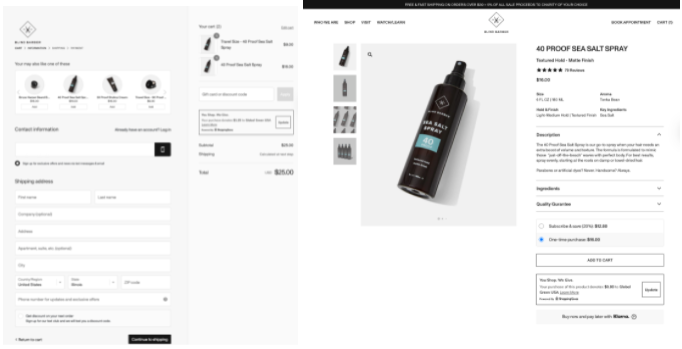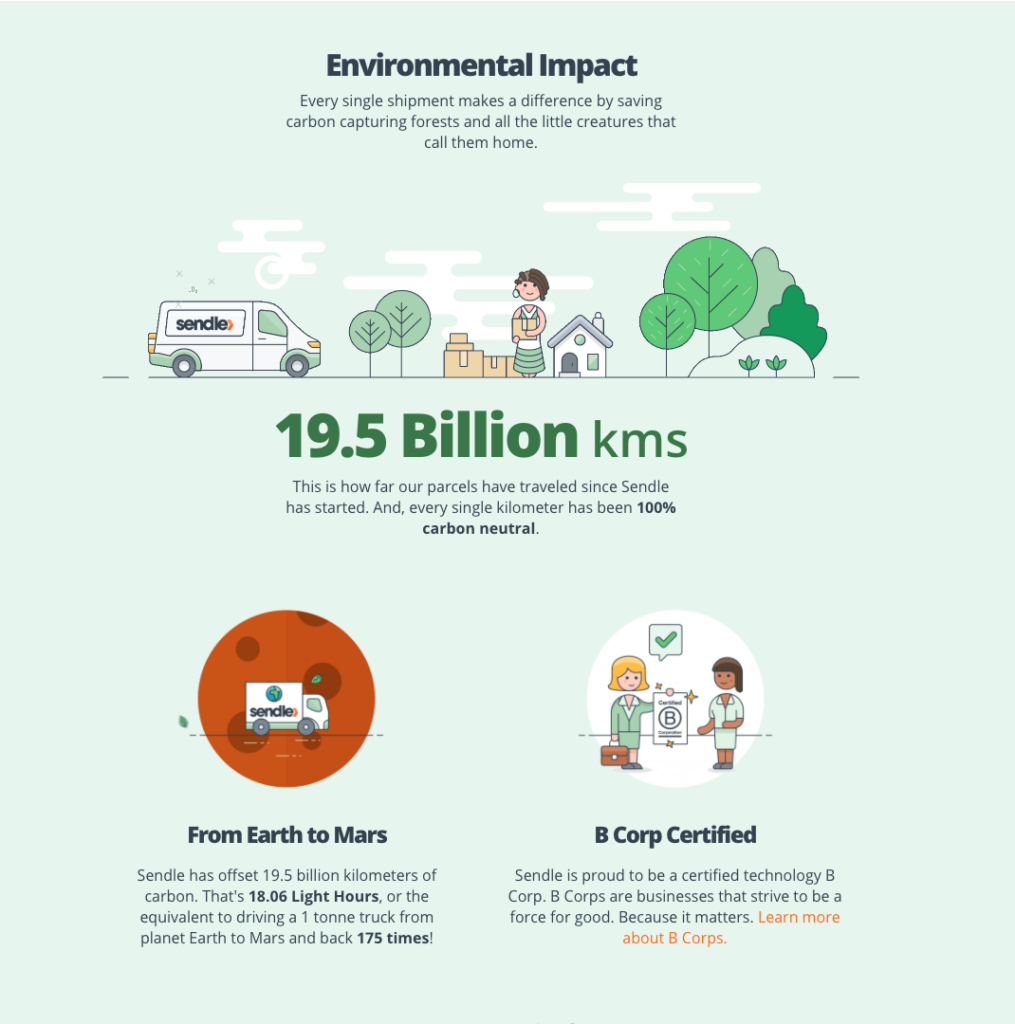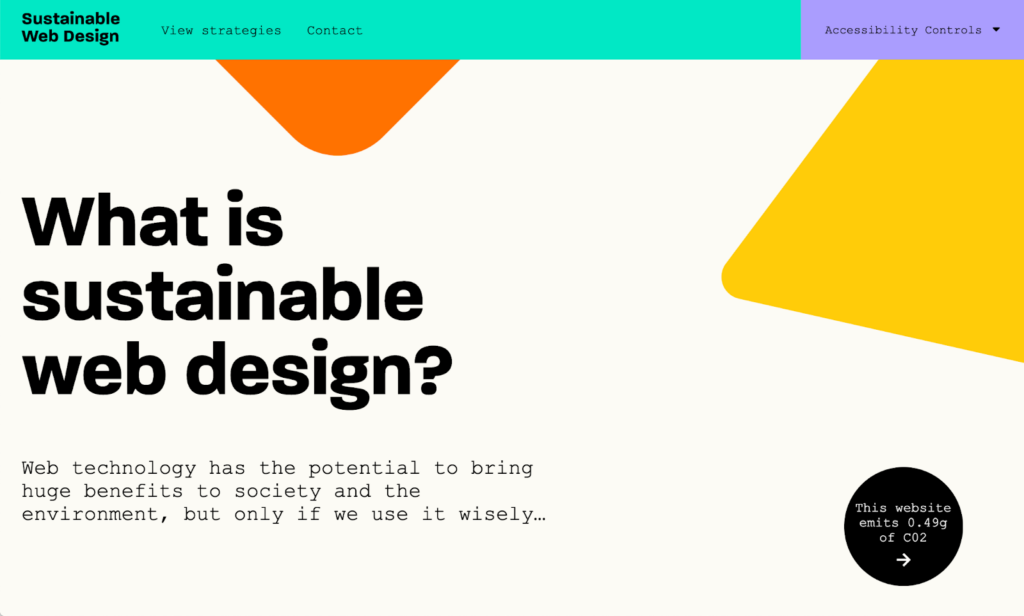With the rising popularity of plug-and-play platforms, the barrier-to-entry for designing online shopping experiences is now lower than ever.
More people have access to online revenue streams, and COVID-19 has made the internet an indispensable tool for getting the goods and services we need to live our locked-down lives. In fact, eMarketer noted that online commerce in the UK alone grew 34.7% from 2019 to 2020.
However, this has not occurred without some challenging consequences. Think rogue online pharmacies, fake storefronts, and web-based credit card fraud.
Ecommerce also has a direct hand in two of the most significant sources of greenhouse gas emissions on the planet: the internet and transportation.
The internet has a larger environmental impact than the commercial airline industry. It produces more emissions each year than most countries – up to 1.6 billion tons annually, by some estimates. Emissions from transportation accounts for 16.2% of total global emissions. These two factors make ecommerce a notable contributor to climate change.
And that’s not all. Here’s a relevant quote from Mike Monteiro’s thought-provoking book, Ruined by Design:
We’ve been designing giant world-wide networks that manage personal relationships, generate abuse and harassment, and can’t tell (or don’t care about) the difference between a good or a bad actor. We’re happy to have Nazis on our platforms because they count as engagement. We’re happy to let people post the addresses of parents of slain children because we can sell ads against it. We’re also designing ‘smart’ devices that can listen to and watch everything we do in our homes. These things are being designed by people who have no idea what their professional ethical code is, or any recourse to deal with designers who break it.
Advertisers are going to great lengths to sell us more stuff, including violating our privacy and exploiting whatever resources they can to increase sales.
However, the rise of ethical shopping and the proliferation of B Corps, sustainable brands, and other avenues for conscious commerce shows that there are better ways to facilitate responsible online shopping.
Designers, developers, and ecommerce managers are in unique positions to influence decision-making when it comes to the ethics and sustainability of products and services. Agencies, in particular, can guide their clients toward more ethical and responsible decision-making with every project they take on.
With all this in mind, how might we design online shopping experiences that make more sustainable or responsible decisions easier?
11 ways to create a more sustainable ecommerce site
At my agency Mightybytes, we are researching corporate digital responsibility (CDR) as a way to improve not only our own digital practices but those of other companies and organizations as well.
Elsevier’s Journal of Business Research defines CDR as a “shared set of values and norms that guide an organization’s operations with respect to the creation and operation of digital technology and data”.
As a Certified B Corp, CDR is a natural extension of the impact work we’re already doing. Certified B Corps are companies that meet the highest verified standards of social and environmental performance, transparency, and accountability. As of this writing, there are about 4,000 of us worldwide and the movement is growing rapidly.
If you’re managing ecommerce solutions, this applies to your work. Let’s explore some more ethical and responsible design decisions you and your team might make.
Lead with transparency.
First, be clear and upfront on everything from your return and privacy policies to where your products come from and how you handle shipping.
Make this information easy to find by including links on individual product pages, search-on-site, and important links in your navigation or footer. If possible, include social proof like customer testimonials or links to your profiles on review platforms like Glassdoor and Clutch.
This may seem like obvious advice. However, bogus online stores don’t often include these, which will differentiate you.
Related Read: The Sustainable Ecommerce Handbook
Align your values
Similarly, purpose-driven customers are more likely to make purchases if they know you share their values. The products you choose to sell and the stories you choose to tell can impact the likelihood of casual visitors becoming satisfied—sometimes even passionate—customers.
Many books have been written on this deep topic. Russ Stoddard’s Rise Up: How to Build a Socially Conscious Business and Christopher Marquis’ Better Business: How the B Corp Movement is Remaking Capitalism are just two examples.
Creating and running a purpose-fueled business goes well beyond the scope of a single article on responsible ecommerce. That said, values alignment between company and customers cannot be overstated as something that’s worth pursuing.

One simple way to increase engagement around common values is to add a philanthropic component to the shopping experience.
Chicago B Corp ShoppingGives, for example, offers a service that facilitates charitable donations as part of the customer journey and checkout process. Shoppers can choose to support causes that align with their values or select from featured causes from the retailer. Participating companies donate a portion of each purchase to the chosen charities.
Choice editing
Choice editing has long been a common process in sustainability circles. It involves limiting the choices people have in order to highlight a more sustainable or environmentally-friendly option. However, in digital parlance, choice editing might also be considered a “dark pattern”. Have any of these situations ever happened to you?
- You register for email updates, but can’t unsubscribe.
- You create an account that then spams your entire contacts list.
- A product or service is automatically added to your shopping cart.
- You click on something that looks like content but is really just a disguised ad or, worse, starts downloading software to your device.
These are dark patterns, UX choices meant to intentionally deceive users into making choices that aren’t necessarily in their best interests.
When choice editing for digital products and services, the line between dark patterns and “green” patterns can sometimes be blurred. For instance, adding carbon offsets by default to a checkout process would be considered a dark pattern. Even though carbon offsets may be a more sustainable choice, users should have the option to make that choice themselves.
Here’s an example of good green choice editing: For products that require a USB power plug, UK B Corp Tiger Global Ltd asks customers during the checkout process whether they require another one for the product. It’s a simple choice that can make a difference.
“Like most of us, many people have drawers and boxes full of power plugs already,” says head of digital/ecommerce Philip Ray. “Using this kind of thinking, we can make the progress required to slow down filling up the world with unnecessary products.”
Many of the suggestions below involve some sort of choice editing.
More sustainable packaging and shipping
Let customers choose more environmentally-friendly packaging options at checkout or while they’re shopping. For customers, this might involve simply clicking a checkbox. The back-end requirements for choices like these, however, are a bit more complicated.
“With the explosion of ecommerce shipping during COVID, it’s more critical than ever to take responsibility for your carbon emissions,” says the CEO of Australian B Corp Sendle, James Chin Moody. “If you design a carbon-neutral business from the start, that’s much easier to do. It just becomes the way you operate.”
Sendle, a delivery startup, prides itself on being the first 100% carbon-neutral delivery service for small businesses in Australia and the United States. The company has offset nine billion miles worth of carbon. They also use packaging that is 100% biodegradable and compostable.

To that end, if you handle fulfillment, find compostable packaging and incorporate that cost into your business model. If your online store only supports drop shipping, reach out to vendors to learn whether they offer planet-friendly options. If not, encourage them to do so. Better yet, seek out suppliers that do that from the beginning if you can.
During the checkout process, incentivize less polluting choices by offering shipping emissions offsets or discounts for more sustainable options. Highlight these options so they are clear and obvious.
Product sorting and differentiation
When customers search for products, include options to sort by location, environmental impact, or similar. This is also an opportunity to provide incentives through discounts for users who select those products.
If you have them, add any certification logos—such as Fair Trade, B Corp, Cradle-to-Cradle, Green America, and so on—to product listings. This will help users more easily discern ethical products from their traditional counterparts.
Printing... yup, still a thing
Believe it or not, people do still print web pages. Though it happens less and less frequently, recipes, bank statements, and contracts are all examples of things people might print out. For ecommerce sites, invoices and receipts will likely top that list.
Rather than relying on default browser printing options, consider how you might use the least amount of resources, like ink or paper, while still providing acceptable results. To do so, treat print equally alongside other media types, like screen and speech.
Although most browsers will change colors by default to save ink when printing, this is often not as effective as a custom solution such as a unique style sheet specifically created for printing.
Sustainable web design
How quickly can your users find the content they need, checkout, sign-up, or surf from page to page?
There’s a whole movement of designers and developers using sustainable web design practices to create high-performing, low-impact digital products that are both people- and planet-friendly. Many of them start by signing the Sustainable Web Manifesto and committing to an internet that is clean, efficient, open, honest, regenerative, and resilient.
For ecommerce sites, this means designing lightweight, fast-loading pages that help users on any browser, device, or assistive technology find content and accomplish tasks as quickly and efficiently as possible.
It also means you need to get a green web host. Try the Green Web Foundation’s directory for starters. For a full list of practices, check out this free educational resource we created with our friends at Wholegrain Digital, another B Corp agency in London.

Online emissions
Adopting the sustainable web design ethos means paying attention to digital emissions. You can use a tool like Wholegrain Digital’s Website Carbon Calculator to estimate individual page emissions, then create a plan to reduce them.
Some hosting companies will provide you with total data transfer rates for your account, which you can use to estimate emissions and purchase carbon offsets. Mightybytes did this as part of our company’s commitment to Net Zero, making our already green web hosting carbon negative.
When committing to a Net Zero strategy, remember to reduce first, then offset what you can’t reduce.
Inclusive experiences
The plug-and-play ecommerce tools I mentioned at the beginning of this article don’t often get high marks for accessibility. Thus, the solutions we build with them could alienate up to 15% of the global population who identify as having some sort of disability and often use assistive technology. Critically, if you’re not paying attention to this, you could get sued.
Commit to using the Web Content Accessibility Guidelines (preferably level “AA” or higher) to improve your website as soon as possible. While automated testing tools like WebAIM’s WAVE or SiteImprove’s browser extensions will quickly help you understand which problems to fix, you’ll get better results by testing with real people using assistive devices, like screen readers.
Fact-check everything
The proliferation of misinformation and fake news in recent years has understandably made people warier of online sources. Be sure to fact-check all your product pages, blog posts, and other content before they go live. Whenever possible, include links to reputable sources that validate your claims.
If your platform includes user-generated content, appropriately resource and support moderators to police forums, comments, and so on. Oh yeah, and be sure to pay those people a living wage.
Privacy and security
Finally, new and emerging privacy laws in Europe (GDPR) and the United States (CCPA) could impact how customers interact with your digital products and services.
For example, if your website uses Facebook’s Pixel, Mailchimp, Google Analytics, or other CRM or performance measurement tools, and you have customers in California or the European Union, you must let users “opt-in” to tracking and storing their information. Neglecting to do so could put you at risk for fines.
Similarly, if your website gets hacked and customer data is leaked, you could be equally liable. Be sure to adhere to security protocols: Keep software up-to-date, don’t save credit card numbers, backup databases at least daily, and use end-to-end encryption and security certificates.
Responsible product design and management is the future
The ubiquity of digital products and services in our personal and professional lives means that the policies and practices we use to govern them become inherently more complex.
Wider access to more cost-effective ecommerce tools can reduce inequalities and improve the quality of life for many. This also strengthens the need for quality assurance and accountability to ensure that online stores maintain responsible practices and adhere to high ethical standards.
Hopefully, the suggestions above can jumpstart your efforts toward more responsible and sustainable ecommerce practices. If you have additional suggestions, I would love to hear them.
Related Read: Conducting A Sustainability Storytelling Audit On Your Online Store


